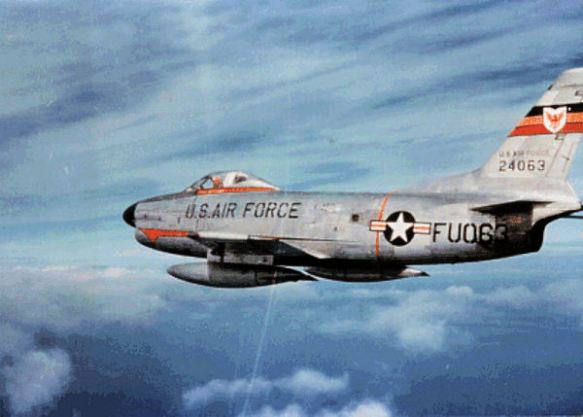
F-86D Serial 52-4063 of the 513th Fighter Interceptor Squadron – Phalsbourg-Bourscheid Air Base France – 1958 Source: United States Air Force Historical Research Agency – Maxwell AFB, Alabama
The mighty Sabre was America’s first sweptwing jet and the world’s first air-superiority fighter. Throughout the Korean War it dominated the sky and shot down formidable Russian MiGs at a 10:1 ratio.
Toward the end of World War II the Army Air Force initiated development of a second-generation jet fighter. Unlike previous aircraft, which were tested and flown without knowledge of German sweptwing technology, North American designed the first such U.S. jet in 1947. The prototype XP86 was a beautiful aircraft with an air scoop in the nose, a large bubble canopy well ahead of the wings, and equally swept tail surfaces. Performance and manoeuvrability were outstanding for the time, so in 1948 it entered production as the F86A Sabre. During testing the Sabre established many world speed and altitude records; during one shallow dive it became the first American jet to break the sound barrier.
The Sabre Dog was the most numerous and most important version of this famous fighter. It was also the first Air Force jet armed entirely with missiles and the first single-seat all-weather interceptor in history.
Faced with the prospect of Soviet bombers attacking over the North Pole, in 1949 the Air Force decided to enhance continental defenses by upgrading the F86 Sabre into an all-weather interceptor. This was no simple task, for the aircraft had to carry the elaborate and heavy APS6 radar/fire-control system. At length North American modified the F86 airframe by fitting the radar into a prominent nose bulge. The air inlet was placed below the dome and the fuselage was widened slightly to accommodate a more powerful engine. Because the traditional armament had been displaced by new electronics, a chin tray that housed a battery of 24 Mighty Mouse unguided rockets was fitted. These would be lowered and fired automatically by the radar. The new craft was so different from other Sabres that it received the temporary designation YF95A, but at length it became known as the F86D. Pilots simply and unofficially referred to it as the Sabre Dog.
The XF86D first flew in 1949 with excellent results, and production was authorized. It thus became the first Air Force jet armed entirely with rockets and the first all-weather interceptor flown by a pilot without a radar operator. Despite the increased weight over other Sabres, the Dog was fast, and in 1951 it overtook itself in two speed records. Ultimately, 2,504 F86Ds were constructed, more than any other version. In 1956 the Air Force upgraded 981 Sabre Dogs into F86Ls by splicing onto them the longer F86H wing. They remained in service with the Air Defense Command until the early 1960s.
Type: Fighter
Dimensions: wingspan, 37 feet, 1 inch; length, 40 feet, 4 inches; height, 15 feet
Weights: empty, 12,470 pounds; gross, 19,000 pounds
Power plant: 1 × 7,650–pound thrust General Electric J47 turbojet engine
Performance: maximum speed, 690 miles per hour; ceiling, 50,000 feet; maximum range, 1,200 miles
Armament: 24 × 2.74–inch Mighty Mouse folding-fin rockets
Service dates: 1951–1961